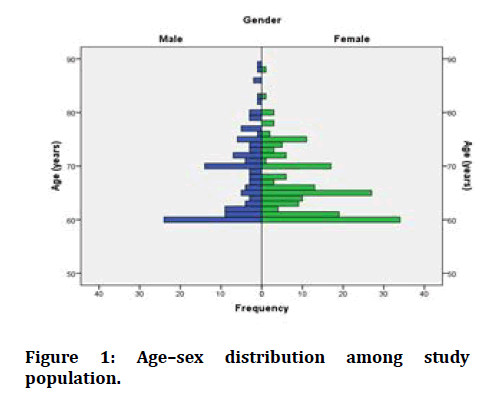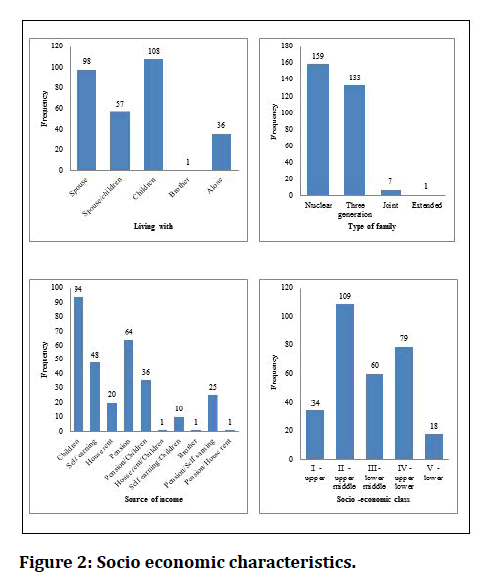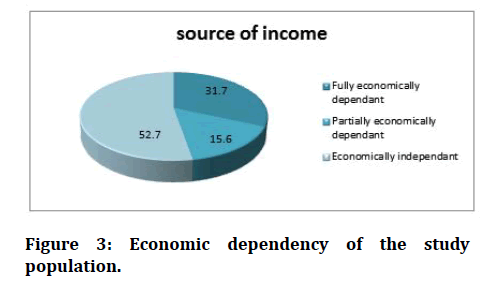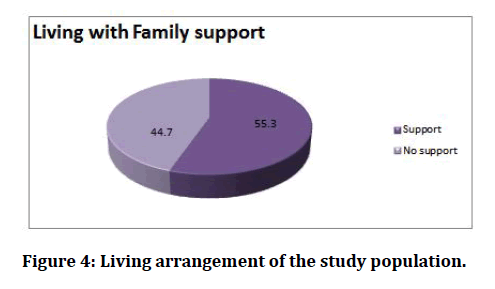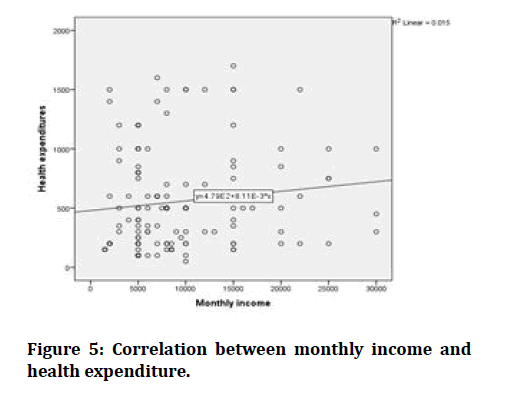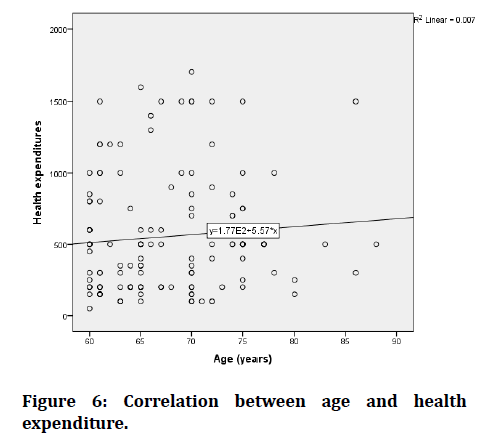Research - (2021) Volume 9, Issue 7
Socio-Economic Determinants of Multimorbidity among the Elderly Population in a Rural Area in Kancheepuram District of Tamil Nadu
Vidhyashree MD1*, Adhilakshmi R2 and Kamini B3
*Correspondence: Vidhyashree MD, Department of community medicine, Government Medical College Omadurar Government estate, India, Email:
Abstract
A major public health challenge in most of the developing countries among elderly population is Multi-morbidity. However, information on the size of population suffering from multi-morbidity and socio-economic differentials of multi-morbidity is scarce. Most often elderly may suffer from multiple chronic conditions leads to socio economic burden which can cause social isolation. Objective: To assess the socio -economic determinants with the multimorbidity among the geriatric population in rural field practice area, Sripuram (RHTC) of Sree Balaji Medical College & Hospital. Methods: A community based cross sectional study conducted among elderly men and women aged above 60 years who belonged to the rural field practice area, Sripuram, located at Kancheepuram district of Tamil Nadu. The required sample size of 300 was arrived by using Simple random sampling technique. Results: Among 300 elders, 55.3 % has support and 55.3% has no support and 12% were living alone. Economically independent elder were 52.7%, fully economically dependent elder were 31.7% and partially economically dependent elder were 15.6%. It was found that only 7.7% elders were clinically free from health problem. Positive Correlations observed between Age and monthly income with Health expenditure. Conclusion: The health problems of the elderly are aggravated by the lack of social security, inadequate accessibility for health care, rehabilitation and recreation. By providing the education on the risk factors of multimorbidity will reduce the socio economic burden of the elderly.
Keywords
Socio-economic determinants, Elderly population, Multimorbidity, Rural field practice area, Health expenditureIntroduction
Globally, the number of persons aged >60 years is expected to nearly triple, increasing from 673 million in 2005 to 2 billion by 2050 [1,2]. Almost 50% of world’s elderly live in Asia, of which 23% live in India. “In 2011, India constitutes of 91 million of elders and expected to increase 177million in 2025” [3]. In county like India, geriatric population account for 7.7 % of the total population, of which two-thirds live in rural area. Most of the elderly are considered to be a social problem in India due to urbanization and nuclearization of their adult children. Multimorbidities and socio-economic status adversely affects old person. A change from salary to pension or unemployment leads to economic loss leading to dependency on their children or relatives. A feeling of low self-worth may be felt due to the loss of earning power and loss of social recognition, which is harmful. The health problems of the elderly in most of the developing countries are aggravated by the lack of social security, inadequate accessibility for health care, rehabilitation and recreation. Studies on the patterns on their socio economic determinants with chronic diseases among elderly can yield information to help in designing comprehensive health care programmes for them.
Objective
To assess the socio-economic determinants with the multimorbidity among the elderly population in rural field practice area.Material and Methods
Study design
A community based cross sectional study conducted among permanent residents of rural area Sripuram, located at 5 kms from Chrompet in Kancheepuram district of Tamilnadu.
Sampling method
The sampling method employed to choose the sample size was simple random sampling. List of elderly staying in the locality was obtained from RHTC. Random numbers were generated using the computer software and the subjects for the study were selected accordingly.
Inclusion criteria
The study subjects included elderly men and women aged > 60 years who belonged to the rural field practice area who gave the consent for the study.
Exclusion criteria
Elderly who were not willing to participate.
Consent and ethical approval
The study was approved by institutional ethics committee of Sree Balaji Medical College. Informed consent in their local language (Tamil) was obtained from the study participants before getting the information from them.
Data collection method
The data was collected by making house to house visits and interviewing all the selected subjects. No inter– observer bias since the subjects were examined by a single examiner.
Results
Among 300 elders studied, 178 (59.3%) were female and 122(40.7%) were male. The age of the subjects in the study population ranged from 60 to 89 years with the mean age of 67 ± 6.5 years (Figure 1). It has a broad base and tapering towards top. A slight higher frequency was seen in females.
Figure 1: Age–sex distribution among study population.
Out of 300 samples studied 159 (53%) of them belonged to nuclear family. And 133 (44.4%) were in three generation type remaining 2.6% were joint or extended type. Socio -economic strata: upper 34(11.3%), upper middle109 (36.4%), lower middle 60(20%), upper lower 79(26.3%) and lower 18(6%) (Figure 2).
Figure 2: Socio economic characteristics.
Figure 3 and 4 shows the socio - economic characteristics: Among 300elders 166 has support (55.3%) and 134 (55.3%) has no support. And 36 (12%) were living alone. Economically independent elder were 158(52.7%), fully economically dependent elder were 95(31.7%) and partially economically dependent elder were 47(15.6%).
Figure 3: Economic dependency of the study population.
Figure 4: Living arrangement of the study population.
Table 1 shows among elderly 105(59%) were widow and 29(23.8%) were widower. And about the literacy level, literacy level, illiterate were high among females 100(56.2%) and unemployed among females were high 140 (78.7%). Table 2 shows the association between socio-economic characteristics with morbidities and the association between source of income and morbidity were more significant, economically dependent elder has more risk for morbidity ( x2=21.9, OR=7.2, pvalue= 0.001). Association between the type of family and morbidity were significant ,nuclear type of family has risk for morbidity (=6.4, OR=0.3, p-value=0.012).Association between family support and morbidity were more significant , when there is no support from the family members there is a risk for the morbidity (=11.0, OR=0.7, p-value=0.001). The present study, socio -economic strata: upper 34(11.3%), upper middle109 (36.4%), lower middle 60(20%), upper lower 79(26.3%) and lower 18(6%).
Table 1: Sex wise distribution of background characteristics.
| S. no | Characteristics | Gender | |||
|---|---|---|---|---|---|
| Male | Female | ||||
| N | % | N | % | ||
| 1 | Age group | ||||
| 60-65 yrs | 54 | 44.3 | 103 | 57.9 | |
| 66-70yrs | 27 | 22.1 | 39 | 21.9 | |
| 71-75 yrs | 23 | 18.9 | 26 | 14.6 | |
| 76 - 80 | 12 | 9.8 | 8 | 4.5 | |
| 81-85 yrs | 2 | 1.6 | 1 | 0.6 | |
| 86 and above | 4 | 3.3 | 1 | 0.6 | |
| 2 | Literacy | ||||
| Illiterate | 27 | 22.1 | 100 | 56.2 | |
| Literate | 95 | 77.9 | 78 | 43.8 | |
| 3 | Occupation | ||||
| Unemployed | 12 | 9.8 | 140 | 78.7 | |
| Employed | 40 | 32.8 | 34 | 19.1 | |
| Pensioners | 70 | 57.4 | 4 | 2.2 | |
| 4 | Marital status | ||||
| Married | 93 | 76.2 | 73 | 41 | |
| Sep/Wid/Single | 29 | 23.8 | 105 | 59 | |
Table 2: Association between socio-economic characteristics with morbidities.
| S.no | Characters | N | Morbidity | Chi square | OR | 95% CI | P value | |
|---|---|---|---|---|---|---|---|---|
| N | (%) | |||||||
| 1 | Source of income | |||||||
| Others | 217 | 210 | 96.8 | 21.9 | 7.2 | 2.8 – 18.1 | 0.001 | |
| Self-earning | 83 | 67 | 80.7 | |||||
| 2 | Type of family | |||||||
| Nuclear | 159 | 141 | 88.7 | 6.4 | 0.3 | 0.1 – 0.8 | 0.012 | |
| Others | 141 | 136 | 96.5 | |||||
| 3 | Family support | |||||||
| No support | 191 | 169 | 88.5 | 11 | 0.1 | 0.01– 0.54 | 0.001 | |
| Support | 109 | 108 | 99.1 | |||||
| 4 | Socio-economic status | |||||||
| Lower | 149 | 144 | 96.6 | 7.8 | 3.9 | 1.4 – 10.8 | 0.005 | |
| Upper | 151 | 133 | 88.1 | |||||
Table 3 shows the morbidity load: It was found that only 23 (7.7%) elders were clinically free from health problem. About 217 (72.3 %) were diagnosed with one to three morbidities and 37 (12.3%) of elderly having four to six morbidities and 23 (7.7 %) elderly having more than 6 morbidities.
Table 3: Multi morbidity burden.
| Number of Morbidity | Gender | |||||
|---|---|---|---|---|---|---|
| Male | Female | Total | ||||
| N | % | N | % | N | % | |
| 0 | 11 | 9 | 12 | 6.7 | 23 | 7.7 |
| 1-3 | 86 | 70.5 | 131 | 73.6 | 217 | 72.3 |
| 4-6 | 11 | 9 | 26 | 14.6 | 37 | 12.3 |
| >6 | 14 | 11.5 | 9 | 5.1 | 23 | 7.7 |
| Total | 122 | 100 | 178 | 100 | 300 | 100 |
Figure 5 represents positive correlation between the monthly income and health expenditure. There is a positive correlation as monthly income increases the expenditure for health also increases. R value is 0.1 which shows a mild positive correlation but the result were not statistically significant (p=0.759).
Figure 5: Correlation between monthly income and health expenditure.
Figure 6 shows a positive correlation between Age and Health expenditure, as age increases the expenditure for health also increases but the results are not significant (R=0.09, p=0.381).
Figure 6: Correlation between age and health expenditure.
Discussion
In our study, Age –sex distribution among study population shows a broad base and tapering towards top. A slight higher frequency was seen in females. In India, generally, persons aged 15 to 59 years are supposed to form the population of working ages and at age 60, people generally retire or withdraw themselves from work. Thus, the Old age dependency ratio is defined as the number of persons in the age-group 60 or more per 100 persons in the age-group 15-59 years [4]. Majority of the elderly persons are out of the work force, which shows that there is increasing risk for them to become financially dependent totally or partially. It is also important to note that a majority of the elderly persons in the rural areas are working in unorganized sectors and not being covered by any social security program [5]. According to Kakkar et al [6] showed working geriatric study group involved in livelihood were found to be less morbid as compared to retired or Homemaker. Another study done in Jamnagar showed 22% of elder were working according to Mahesh et al [7].
Older persons with intact marriages tend to have higher levels of survival and better mental health, utilize more health services and have a better life satisfaction than those without partners [8]. Widowhood is higher among women because they marry men much older to them. According to Kumar et al [9] showed 44.6% widowed, a study done in Vedapatti with their spouses and children. Thus, two or more primary families are joined horizontally [10]. In our study, among elderly 105(59%) were widow and 29(23.8%) were widower. And about the literacy level, illiterate were high among females 100(56.2%) and unemployed among females were high 140 (78.7%).
Financial dependency
A person is considered economically independent if he/she does not require taking financial help from others in order to live a normal life [4]. Above the age of 60 years, for the poor and infirm persons government of Tamil Nadu provides an old age pension of Rs. 1000 per month. A study done in rural areas of Bangladesh Munsur et al [11] majority of women were widowed (63.9%) and 76% were economically dependent. India has an inadequate social security provision for its elderly population. In our study, a positive correlation between Age and the monthly income with the Health expenditure, as age increases the expenditure for health also increases but the results are not significant
In our study, among 300elders 166 has support (55.3%) and 134 (55.3%) has no support. And 36 (12%) were living alone. Economically independent elder were 158(52.7%), fully economically dependent elder were 95(31.7%) and partially economically dependent elder were 47(15.6%). Another study by Padda et al [12] showed 68.39% aged persons were independent while 31.61% were dependent on other family members. Another study done in Aurangabad by Jadhav et al [13] showed 199 (67%) males were economically independent while 98 (32.99%) were economically dependent on children and 185 (56.40%) females were economically dependent on their children or relatives while 143 (43.89%) were economically independent.
Social security
According to Ingle et al [3] the facilities like Social security and Pension was restricted to those who have worked in the public and organized sector of industry which hardly covers about 11% of elders and the majority (89%) remains uncovered with any social security protection.
Socio-economic status
Out of 300 samples studied 159 (53%) of them belonged to nuclear family. And 133 (44.4%) were in three generation type remaining 2.6% were joint or extended type. Socio -economic strata: upper 34(11.3%), upper middle109 (36.4%), lower middle 60(20%), upper lower 79(26.3%) and lower 18(6%). According to Zimmer et al. [14,15], it is essential to have high individual socioeconomic status for better functional status and survival of the elderly. Socio -economic status is important reason for the financial problems of old people. The health and wellbeing of the elderly are affected by many aspects of their social and physical environment which includes life - style, marital status, income, work, retirement, family support, social networks and environmental factors like condition of housing. Another study by Kamble et al. [16] at Ahmednagar district of Western Maharashtra shows the majority of morbidity were in class IV and class V for whom treatment may not be affordable.
The above Venn diagram (Figure 7) shows the overlapping of major morbidities found among rural elderly .The three common morbidities are diabetes (118), musculo–skeletal (112) and hypertension (107). Among 118 diabetes, 78 has hypertension, 48 has musculoskeletal disease. Among 112 musculoskeletal disease, 55 has hypertension and 48 has diabetes. Among 107 hypertensive, 78 has diabetes and 55 has musculoskeletal disease. And 41 elders having all the three morbidities. Hence, the result shows that the occurrence of multi-morbidities is very common among our study population. According to Pallavi et al [17] the pattern of multi morbidity shown by Venn diagram, the overlapping of major morbidities found among rural elderly in Odisha. Shows the three common morbidities are arthritis (164), chronic obstructive pulmonary disease (62) and high blood pressure (60). Amongst 164 elderly people having arthritis about 62 (37%) are suffering from chronic obstructive pulmonary diseases, 60 (36%) are having high blood pressure and (8)5% are having all the three morbidities. In our study it was found that only 23 (7.7%) elders were clinically free from health problem. About 217 (72.3 %) were diagnosed with one to three morbidities and 37 (12.3%) of elderly having four to six morbidities and 23 (7.7 %) elderly having more than 6 morbidities.
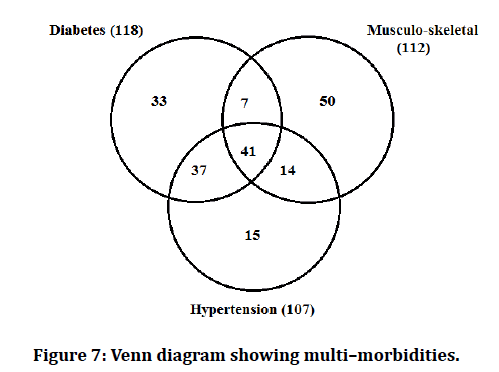
Figure 7: Venn diagram showing multi–morbidities.
Conclusion
To reduce the socio economic burden of the elderly, we need to educate both the geriatric population and their children about the risk of multi–morbidities, social security and financial dependency.
Conflict of Interest
Nil.
References
- Banjare P, Pradhan J. Socio-economic inequalities in the prevalence of multi-morbidity among the rural elderly in Bargarh District of Odisha (India). PLoS ONE 2014; 9:e97832.
- http://www.un.org/esa/population/publications/wpp2006/English.pdf
- Ingle GK, Nath A. Geriatric health in India: Concerns and Solutions. Indian J Community Med 2008; 33:215.
- http://mospi.nic.in/mospi_new/upload/elderly_in_india.pdf.
- Kumar V. Ageing in India- An overview. Indian J Med Res 1997; 106:257-264.
- Kakkar R , Pradeep A. An epidemiological study to assess morbidity profile among geriatric population in district dehradun. Indian J Community Health 2013; 25.
- Mahesh C, Suraj K. Morbidity pattern and treatment seeking behaviour of geriatric population in Jamnagar city. J Res Med Dent Sci 2013; 1.
- http://www.un.org/esa/ population/pubsarchive/catalogue/catint2.htm
- Kumar A T, Sowmiya KR. Morbidity pattern among the elderly people living in a southern Rural India-A cross sectional study. Nat J Res ComMed 2012; 1:1-60.
- Suriyakantha AH. Community medicine with recent advances. 3rd Edn. Jaypee Brothers Medical Publishers 2014; 702.
- Munsur AM, Tareque MD, Rahman KMM. Determinants of living arrangements, health status and abuse among elderly women: A study of rural Naogaon District, Bangladesh. J Int Women’s Studies 2010; 11.
- Padda AS, Mohan V. Health profile of aged persons in urban & rural field practice areas of medical college, Amrisar. 1998; 23:72-76.
- Jadhav VS, Mundada VD. A study of demographic pattern among geriatric population in the field practice area of rural health training centre, paithan of govt. medical college, Aurangabad. Int J Recent Trends Sci Technol 2012; 3:25-28.
- Chanana HB, Talwar PP. Aging in India: Its socioeconomic and health implications. Asia-Pacific Population J 2014; 2.
- Zimmer Z, Wen M, Kaneda T. A multi-level analysis of urban/rural and Socio-economic differences in functional health status transition among older Chinese. Social Sci Med 2010; 71:559-567.
- http://medind.nic.in/ ice/t12/i8/icet12i8 p295.pdf
- Kumar R, Shafee M. Assessment of morbidity pattern and its correlates among elderly population in rural area of Perambalur, Tamilnadu, India. IJBR 2014; 5.
Author Info
Vidhyashree MD1*, Adhilakshmi R2 and Kamini B3
1Department of community medicine, Government Medical College Omadurar Government estate, Chennai, Tamil Nadu, India2Department of Community Medicine, Kilpauk Medical College, Chennai, Tamil Nadu, India
3Department of Community Medicine, Muthukumaran Medical College, Chennai, Tamil Nadu, India
Citation: Vidhyashree MD, Adhilakshmi R, Kamini B,Socio-Economic Determinants of Multimorbidity among the Elderly Population in a Rural Area in Kancheepuram District of Tamil Nadu, J Res Med Dent Sci, 2021, 9(7): 436-441
Received: 08-Jul-2021 Accepted: 27-Jul-2021

